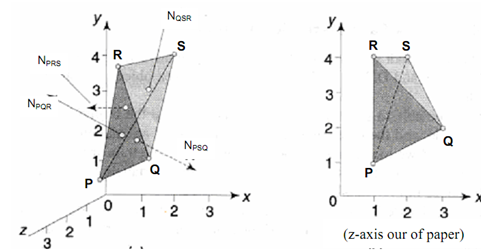Back-Face Detection Method Naming Directions:
Now the outward normal of the four faces, found by taking the cross product of any two adjacent edges of each polygon are found to be as follows :
N PQR = - 4i + 2 j + 6k
NQSR = 2i + 4 j + 2k
N PRS = - 3i - j - 3k
N PSQ = 5i - 5 j - 5k
The sign of the coefficients of k shall determine the direction in which each normal is pointing, positive being in the positive direction of the z-axis. Actually, it is sufficient to compute only the coefficient of k as ( x2 - x1 ) ( y3 - y 1 ) - ( x2 - x1 ) ( y2 - y1 ) , and avoid calculation of the coefficients of i and j. The normal vectors are given in full only to indicate their orientations in Figure (a), with the two normals with positive k values being marked in full lines, and the two with negative k values being marked in broken lines.

(a) (b)
Figure: Back-Face Detection Worked Example : (a) Normals; and (b) Display
In the current case, the coefficients of k for the faces PQR and QSR are positive, and thus those two faces are visible, whereas the other two faces PRS and PSQ with negative k coefficients are hidden from view. Therefore, the display shall be as illustrated in Figure (b), with the hidden edge PS illustrated in thin broken line.